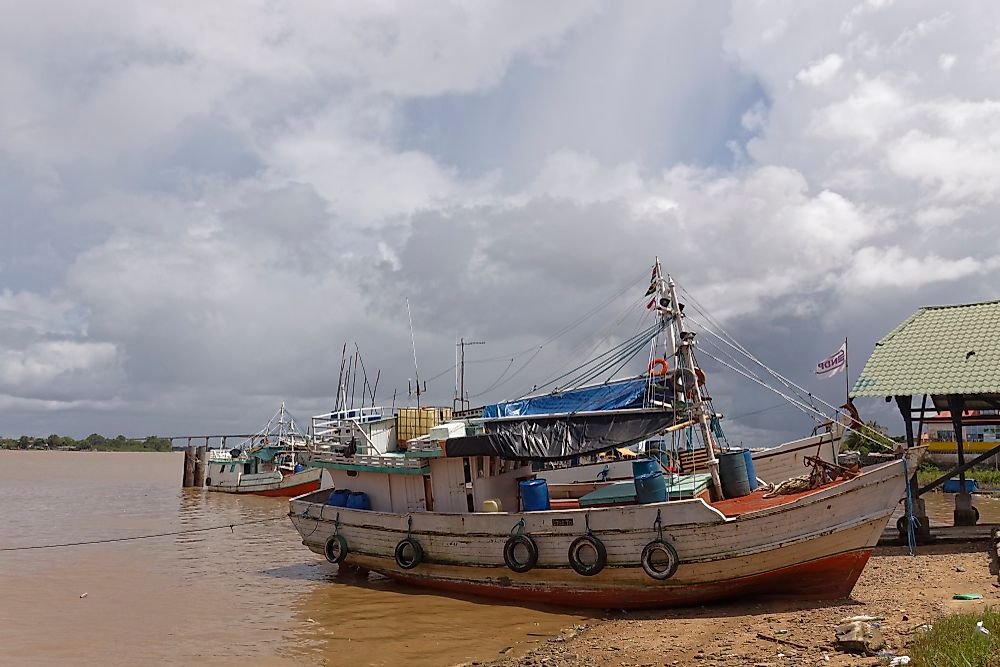What Are The Biggest Industries In Suriname?

The Republic of Suriname is located in the northeastern Atlantic coast in South America and is bordered to the north by the Atlantic Ocean, to the south by Brazil, to the east by French Guiana, and to the west by Guyana. It is South America’s smallest sovereign state, covering an area of approximately 64,000 square miles. It has a population of about 558,300 people of which the majority are living on the country’s north coast and in the capital Paramaribo. During the Dutch colonial period, Suriname was a chief sugar colony whose plantation economy depended on African slaves.
Suriname’s Economic Outlook
According to Euromoney Country Risk ranking (2011), Suriname is the world’s 124th safest investment destination. Following the turbulent 1990s, the country’s democracy gained some strength and the economy became less dependent on Dutch financial aid and more diversified. The discovery of natural resources such as bauxite, gold, and oil have increased its revenue sources and economic independence. Agriculture remains a strong contributor to the economy. Ecotourism is the newest source of revenue for the country. The economy of Suriname is dependent on commerce, with major partners including Canada, the US, Netherlands, and Caribbean countries. The major hindrance to investment in Suriname is the time it takes to register a new business (694 days). The country has both large and small industries that are both significant to its economic growth. Here are some of the biggest industries in Suriname:
Bauxite Industry
The economy of Suriname is dominated by the bauxite industry, accounting for more than 15% of the country’s GDP and over 70% of export revenue. This industry is responsible for the production of alumina and small amounts of aluminum. In 2001, alumina export accounted for 72% of the country’s estimated export revenue of UD$ 497 million. Suriname’s bauxite is one of the richest in the world and has high demand, especially from trading partners such as the US, Canada, and Switzerland. In 1995, the bauxite refinery near the capital Paramaribo produced approximately 1.5 million tons of alumina and 32,000 tons of aluminum. In 1999, the government closed the aluminum smelter near Paranam and mining at Onverdatch stopped. The low cost of power is one of the main advantages of energy-intensive alumina and aluminum production. The major mining sites include Lelydorp and Moengo. Other proven reserves are located in north, west, and east of the country. In recent years, the bauxite industry has largely been affected by the depressed by the international prices for alumina.
Gold Industry
The gold industry has added sustainability to the economic independence of Suriname. Gold has been a major economic asset for the country for over a century. The country’s long history of gold mining, especially in larger parts of greenstone belt in the northern part of the country started with small-scale artisanal extraction but has since developed into major open-pit operations. However, Suriname’s gold deposits remain largely underexplored. In 2013, the country produced approximately 808,000 oz of gold, of which 46% was produced by the Rosebel Mine and the rest by artisanal miners. There are about 20,000 artisanal miners engaged in gold production but only 115 were registered by the government as of 2009. Illegal mining is also rampant, making it almost impossible for the government to account for the amount of gold the country produces. Despite the positive growth in gold production and the gold sector, there is still little knowledge on the origin and evolution of gold deposits in Suriname, hindering the expected growth of the sector. Although gold mining is an important economic activity, it has caused serious environmental damages.
Oil Industry
The oil sector is one of the promising sectors in Suriname with the potential to improve the country’s export earnings. The country’s proven oil reserve is estimated to be 170 billion barrels, of which 42 million have already been produced. The exploitation of fossil fuel is solely done by the state-owned State Oil Company of Suriname, known as Staatsolie. The company produced 16,200 barrels of oil in 2012 compared to 12,500 barrels in 1999 and currently refines 7,350 barrels per day at Tout Lui Faut, the country’s only oil refinery. The government is currently working at increasing the production to 15,000 barrels per day. Most of the oil wells are located in rice farms and private property, with a 60-kilometer pipeline running through the property.
Farming Industry
Agriculture, especially banana and rice farming, is one of the major components of the economy. Large-scale agricultural activities have long been practiced in the coastal areas of Suriname. Agricultural enterprises were established along the coastal area by white settlers to supply them with agricultural products such as cotton, cacao, coffee, and sugar. Today, the agricultural sector employs approximately 12% of the total workforce. Rice accounts for about 10% of Suriname’s export while banana accounts for 2.5% of the total export revenue. Other agricultural products include plantain, coconuts, sugar, and palm kernels. In the 18th century, coffee production was of great importance under the Dutch colony but is no longer a major product. Animal husbandry is mainly restricted to the coastal plains where large cattle farms have been established. The chicken industry is also growing but has faced competition from cheaper chicken imported from the US.
Forestry
Suriname’s forestry sector has captured the attention of the international companies that are interested in investing in the tropical hardwood industry. Suriname has one of the highest proportion of rainforest cover in the world. About 75% of the country’s surface area, 14-15 million hectares, is covered in rainforest, making it an attractive source of hardwood. Big companies are currently obtaining hardwood from the forests. However, wood extraction does not take place according to the prescribed ways, raising environmental concern and opposition, especially from the indigenous communities.











